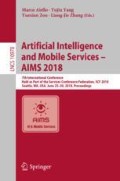Abstract
Infant crying is a main trouble for baby caring in homes. Without an effective monitoring technology, a babysitter may need to stay with the baby all day long. One of the solutions is to design an intelligent system which is able to detect the sound of infant crying automatically. For this purpose, we present a novel infant crying detection system (AICDS in short), which is designed in the client-server framework. In the client side, a robot prototype bought in the market is installed beside the baby carriage, which is equipped a small microphone array to capture sound signals and transmit it to the cloud server with a Wi-Fi module. In the cloud server side, a lightweight convolution neural network model is proposed to identify infant crying or non-infant crying event. Experiments show that our AICDS achieves 86% infant crying detection accuracy, which is valuable to reduce the workload of the babysitters.
Access this chapter
Tax calculation will be finalised at checkout
Purchases are for personal use only
References
Kristian, Y., Hariadi, M., Purnomo, M.H.: Ideal modified adachi chaotic neural networks and active shape model for infant facial cry detection on still image. In: IEEE International Joint Conference on Neural Networks, pp. 2783–2787 (2014)
Cohen, R., Lavner, Y.: Infant cry analysis and detection. In: IEEE Electrical & Electronics Engineers in Israel, pp. 1–5 (2012)
Lavner, Y., et al.: Baby Cry Detection in Domestic Environment Using Deep Learning. Social Science Electronic Publishing, New York (2016)
Huang, W., et al.: Scream detection for home applications. In: IEEE Industrial Electronics and Applications, pp. 2115–2120 (2010)
Huemmer, C., et al.: Online environmental adaptation of CNN-based acoustic models using spatial diffuseness features. In: IEEE International Conference on Acoustics, Speech and Signal Processing, pp. 4875–4879 (2017)
Szegedy, C., et al.: Rethinking the inception architecture for computer vision. In: IEEE Conference on Computer Vision and Pattern Recognition (CVPR), pp. 2818–2826, Las Vegas, NV, USA, 27–30 June 2016
Agoes, A.S., Hu, Z., Matsunaga, N.: Fine tuning based squeezenet for vehicle classification. In: International Conference on Advances in Image Processing (ICAIP), pp. 14–18, Bangkok, Thailand, 25–27 August 2017
Sun, T., et al.: Convolution neural networks with two pathways for image style recognition. IEEE Trans. Image Process. PP(99), 1–1 (2017)
El-Sawy, A., et al.: CNN based on LeNet-5. In: Proceedings of the International Conference on Advanced Intelligent Systems and Informatics (2016)
Jia-Hui, X.U., et al.: A Design of AC97 Audio System Based on Vivado HLS. Research & Exploration in Laboratory (2014)
Balakrishnan, H., et al.: Improving TCP/IP performance over wireless networks. In: International Conference on Mobile Computing and Networking, pp. 2–11. ACM (1995)
Uhlich, S., et al.: Improving music source separation based on deep neural networks through data augmentation and network blending. In: IEEE International Conference on Acoustics, Speech and Signal Processing (2017)
Faubel, F., Mcdonough, J.W., Klakow, D.: A phase-averaged model for the relationship between noisy speech, clean speech and noise in the log-mel domain. In: IEEE Conference of the International Speech Communication Association INTERSPEECH 2008, Brisbane, Australia, September DBLP, pp. 553–556 (2008)
Mccowan, I., et al.: The delta-phase spectrum with application to voice activity detection and speaker recognition. IEEE Trans. Audio Speech Lang. Process. 19(7), 2026–2038 (2011)
Keskar, N.S., Saon, G.: A nonmonotone learning rate strategy for SGD training of deep neural networks. In: IEEE International Conference on Acoustics, Speech and Signal Processing, pp. 4974–4978 (2015)
Pang, T., Du, C., Zhu, J.: Robust Deep Learning via Reverse Cross-Entropy Training and Thresholding Test (2017)
Huzaifah, M.: Comparison of time-frequency representations for environmental sound classification using convolutional neural networks (2017). arXiv preprint arXiv:1706.07156
Dai, W., et al.: Very deep convolutional neural networks for raw waveforms. In: IEEE International Conference on Acoustics, Speech and Signal Processing (ICASSP). IEEE (2017)
Piczak, K.J.: Environmental sound classification with convolutional neural networks. In: IEEE 25th International Workshop on Machine Learning for Signal Processing (MLSP). IEEE (2015)
Acknowledgement
This project was partially supported by Shenzhen Science & Technology Fundamental Research Programs (No: JCYJ20170306165153653, JCYJ20170817160058246) and Shenzhen Key Laboratory for Intelligent MM and VR (ZDSYS201703031405467).
Author information
Authors and Affiliations
Corresponding author
Editor information
Editors and Affiliations
Rights and permissions
Copyright information
© 2018 Springer International Publishing AG, part of Springer Nature
About this paper
Cite this paper
Zhang, X., Zou, Y., Liu, Y. (2018). AICDS: An Infant Crying Detection System Based on Lightweight Convolutional Neural Network. In: Aiello, M., Yang, Y., Zou, Y., Zhang, LJ. (eds) Artificial Intelligence and Mobile Services – AIMS 2018. AIMS 2018. Lecture Notes in Computer Science(), vol 10970. Springer, Cham. https://doi.org/10.1007/978-3-319-94361-9_14
Download citation
DOI: https://doi.org/10.1007/978-3-319-94361-9_14
Published:
Publisher Name: Springer, Cham
Print ISBN: 978-3-319-94360-2
Online ISBN: 978-3-319-94361-9
eBook Packages: Computer ScienceComputer Science (R0)

